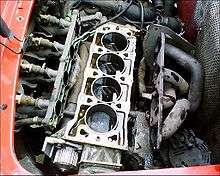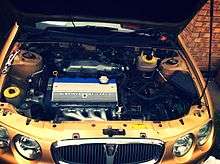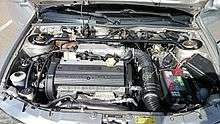Rover K-series engine
| Rover K series | |
|---|---|
 | |
| Overview | |
| Manufacturer |
Rover Group MG Rover Group/Powertrain Ltd |
| Production | 1988–2005 (K series) |
| Layout | |
| Configuration | Straight-4 |
| Displacement | 1,120 cc (68 cu in) to 1,796 cc (109.6 cu in) |
| Cylinder block alloy | cast Aluminium |
| Cylinder head alloy | cast Aluminium |
| Valvetrain | SOHC and DOHC |
| Combustion | |
| Fuel system | Carburetor or Rover MEMS |
| Fuel type | petrol |
| Cooling system | water-cooled |
| Chronology | |
| Predecessor | |
| Successor | SAIC Kavachi engine |
The K-series engine is a series of engines built by Powertrain Ltd, a sister company of MG Rover. The engine was built in two forms: a straight-four cylinder, available with SOHC and DOHC, ranging from 1.1 litres to 1.8 litres.
Design history

The K series was introduced in 1988 by Rover Group as a powerplant for the Rover 200 car. It was the second volume-production implementation of the low-pressure sand-casting (or LPS) technique in a new plant sited between East Works and Cofton Hackett. (The first volume application of the LPS process had been for the M-16 cylinder head, produced in South Works, adjacent to the former forge). The LPS process pumped liquid aluminium into a chemically-bonded sand mould from below. This reduced oxide inclusions and gave a casting yield of around 90%, compared with 60% for more conventional gravity casting processes. The process avoided many of the inherent problems of casting aluminium components and consequently permitted lower casting wall thickness and higher strength-to-weight ratios. However, the process required the use of heat-treated LM25 material which gave the engines a reputation for being fragile. An engine overheat would often result in the material becoming annealed and rendering the components scrap. The layout of the engine bay on some Rover cars fitted with K-series engines – particularly the MGF with its mid-engined layout – means that a commonly-occurring coolant leak under the inlet manifold can go undetected until severe damage has been done to the head. The aluminium engine blocks were fitted with spun-cast iron cylinder liners that were initially manufactured by GKN's Sheepbridge Stokes of Chesterfield, but these were replaced by liners made by Goetze after some seminal research conducted by Charles Bernstein at Longbridge, which proved influential even to Ducati for their race engines. Unfortunately a large number of aftermarket engines, the so-called "VHPD's", were built with the old substandard GKNs by Minister, Lotus and PTP well after the Goetze liner's introduction to the production line in 2000.
The engine was introduced initially in 1.1-litre single overhead cam and 1.4-litre dual overhead cam versions. Because Honda stopped providing Rover with engines after the end of their relationship, but well before the BMW takeover, an enlargement of the K Series design to 1.6 and 1.8 litres was carried out. This was done by using larger diameter cylinder liners and also increasing the stroke. The change required a block redesign with the removal of the cylinder block's top deck and a change from "wet" liners to "damp" liners.[1] The plastic throttle body fitted to the engine until 2001 was manufactured by the SU Carburettor company. They also included aluminium and larger sized bodies.
The four-cylinder engines were held together as a sandwich of components by long through-bolts which held the engine under compression, though this construction is not unknown, and was used in early lightweight fighter engines from the First World War. It had also been used in motorcycle engines and Triumph Car's "Sabrina" race engine.
The two types of head that were bolted to the common four-cylinder block were designated K8 (8 valves) and K16 (16 valves). A later head design also incorporated a Rover-designed Variable Valve Control (VVC) unit (derived from an expired AP patent). This allowed more power to be developed without compromising low-speed torque and flexibility. The VVC system constantly alters the inlet cam period, resulting in a remarkably flexible drive: the torque curve of a VVC K-series engine is virtually flat throughout the rev range and power climbs steadily with no fall-off whatsoever until the rev limiter kicks in at 7,200 rpm.
Following the collapse of MG Rover in 2005, the Chinese automaker Nanjing Automobile acquired the Longbridge plant and the intellectual property rights to many designs, including those of the K series engine. The Chinese owner, now SAIC Motor, went on to further develop the K series engine, renaming it "N series" and using it to power its current range of MG cars, the MG 6. The revisions included a different design of cylinder head gasket, higher tensile strength through-bolts and a stronger oil-rail fitted in the bottom end of the engine that the through bolts screw into. These revisions are sold by the British company XPart to solve the issues that some K series engines had of cylinder head gasket failure.[2]
Engine management
K8 engine
Early K8 engines used a single SU KIF carburetter with a manual choke and a breaker-less distributor mounted on the end of the camshaft. MEMS Single point injection became standard with the launch of the Rover 100 in 1994.
K16
K16 models used MEMS, with a 1.6 ECU from 1990 until 1994 and a 1.9 ECU from 1995 onwards, in either Single Point or Multi Point forms, with a single coil on the back of the engine block and a distributor cap and rotor arm on the end of the inlet camshaft. MEMS 2J was used on the VVC engine, to control the Variable Valve Control and the distributorless ignition system, which was used because there were camshaft drive belts at both ends of the engine. With the launch of the Rover 25 and Rover 45 in 1999, MEMS 3 was introduced, with twin coils and sequential injection.
Model range
1100
.jpg)
All 1100 engines displace 1.1 L (1,120 cc/68 cu in). Four variations were created:
- SOHC K8 8-valve, Carburettor, 60 hp (44 kW)
- SOHC K8 8-valve, SPI, 60 hp (44 kW)
- SOHC K8 8-valve, MPI, 60 hp (44 kW)
- DOHC K16 16-valve, MPI, 75 hp (55 kW)
Cars that came with the 1100:
1400
Engine Codes: 14K2F (8V), 14K4F (16V), 14K16 (16V)?
All 1400 engines displace 1.4 L (1,396 cc/85 cu in). Six variations were created:
- SOHC K8 8-valve, Carburettor, 75 hp (55 kW)
- SOHC K8 8-valve, SPI, 75 hp (55 kW)
- SOHC K8 8-valve, MPI, 75 hp (55 kW)
- DOHC K16 16-valve, SPI, 90 hp (66 kW)
- DOHC K16 16-valve, MPI, 82 hp (61 kW)
- DOHC K16 16-valve, MPI, 103 hp (76 kW)
The K16 82 hp variant is exactly the same as the 103 hp (77 kW) version, apart from a restrictive throttle body designed to lower the car's insurance group. This can be converted to the 103 hp (77 kW) model by changing to the unrestricted throttle body of a 103 engine. The 90 hp (67 kW) Spi features single-point fuel injection rather than the multi-point of the later engine.
Cars that came with the 1400:
- Rover Metro
- Rover 100
- Rover 200
- Rover 25
- Rover 400
- Rover 45
- Rover Streetwise
- MG ZR
- MG ZS – Ireland and Portugal only
- Caterham Seven
- GTM Libra
- GTM K3
- FSO Polonez Caro/Atu
- Reliant Scimitar Sabre
1600
Engine Code: 16K4F
All 1600 engines displace 1.6 L (1,588 cc/96 cu in) and have DOHC, 16 valves and MPI. Two variations were created:
- 109 hp (80 kW)
- 111 hp (82 kW)
Cars that came with the 1600:
- Rover 200
- Rover 25
- Rover Streetwise
- Rover 400
- Rover 45
- MG ZS
- MG F
- MG TF
- Caterham Seven
- Caterham 21
1800

Engine Codes: 18K4F, 18K4K (VVC variants)
All 1800 engines displace 1,795 cc (1.8 L; 109.5 cu in) with bore 80 mm (3.15 in) X stroke 89.3 mm (3.52 in) DOHC 4 valves per cylinder and MPI. Six versions were created:
- 120 bhp (122 PS; 89 kW) @ 5600 rpm and 124 lb⋅ft (168 N⋅m) @ 3500 rpm of torque.[3][4]
- 136 hp (100 kW)@6750rpm/ 165 Nm@3000 rpm
- VVC, 143 hp@7000rpm (107 kW) / 174 Nm@4500 rpm
- VVC, 158 hp@7000rpm(118 kW) / 174 Nm@4700 rpm
- turbocharged, 150 to 160 hp (110 to 118 kW)
- VHPD – Very-high-performance derivative, 177 hp (130 kW) or 192 hp (142 kW) (Lotus version) (Uses VVC unique cylinder head casting (similar to VVC casting), has big valves, but with fixed cam timing – No development input was requested from Rover)
Cars that came with the 1800:
- Rover 200 (120HP, 145 HP VVC)
- Rover 25 (120HP, 145 HP VVC)
- Rover 45 (120 HP)
- Rover Streetwise (120HP)
- Rover 75 (120 HP, 150 HP Turbo)
- MG ZR (120 HP and 160 HP VVC)
- MG ZS (120 HP)
- MG ZT (120HP, 160 HP Turbo)
- MG F (120 HP, 145 HP VVC and 160 HP VVC)
- MG TF (120HP, 135 HP and 160 HP VVC)
- Ariel Atom1
- Lotus Elise S1 and S2 until circa 2005
- Lotus Exige
- Land Rover Freelander (120 HP)
- Caterham Seven
- Caterham 21
- GTM Libra
Kavachi engine
Kavachi engine is an extensively improved version of the Rover K series, using a different turbo and gearbox, improved head gasket and strengthened block. UK engineering firm Ricardo plc, expert in race engine designs, was commissioned to not only redesign the engine but also the manufacturing process to produce what is now a very reliable engine. It is only available in 1.8 (1796 cc) version.
References
- ↑ Adcock, Ian (1996). Project Phoenix: the birth of the MGF. Bloomsbury. p. 175. ISBN 0-7475-2695-8.
- ↑ "XPart provides Caterham owners with 'ultimate fix' for K-series engine". Motorsport Industry Association. 2 December 2009. Archived from the original on 5 March 2014. Retrieved 1 March 2014.
- ↑ "2001 Lotus Elise S2 1.8 technical specifications". ultimatespecs.com. Retrieved June 23, 2018.
- ↑ "Lotus Elise S2 Type 25". ultimatecarpage.com. Retrieved June 23, 2018.
External links
- Austin Memories – History of Austin and Longbridge
- Kmaps Remaps – Provides remapping services for the Rover K-series engines.
Further reading
- Engine Overhaul Manual. Rover K Series. MG Rover Group.
- Hammill, Des (2008). The Rover K-series 16V Engine. 1989-2005. CP Press. ISBN 1-84155-688-2.
